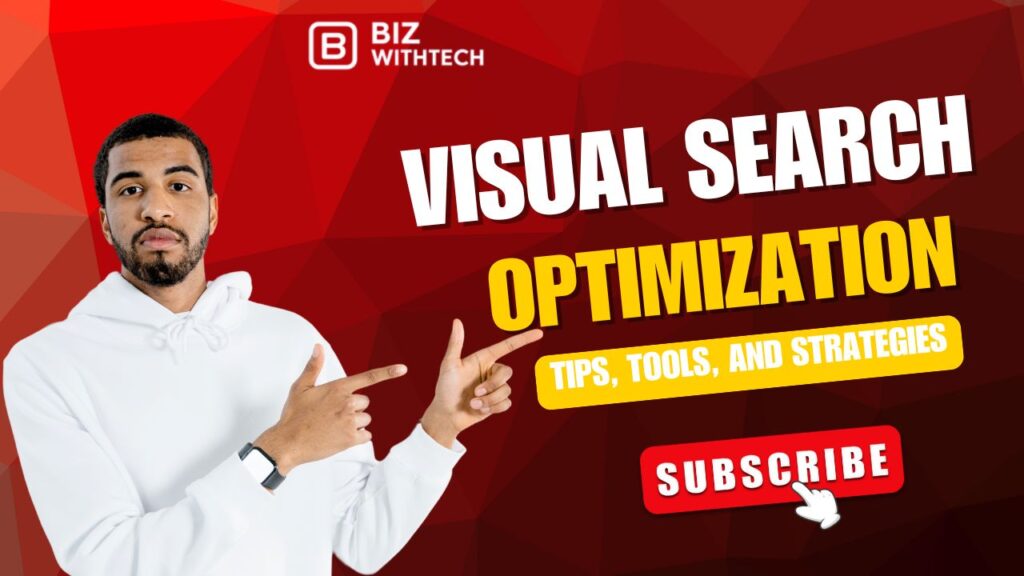Visual search is revolutionizing how consumers discover and purchase products online. Instead of typing keywords, users can now snap a photo or upload an image to find similar items, identify products, or gather information. With platforms like Google Lens processing billions of visual searches monthly and Pinterest reporting that 600 million visual searches happen on their platform each month, optimizing your content for visual search is no longer optional—it’s essential.
This comprehensive guide will walk you through everything you need to know about visual search optimization, from fundamental principles to advanced strategies that will help your brand stay ahead of the curve.
What Is Visual Search?
Visual search technology uses artificial intelligence and machine learning to analyze the content of images and return relevant results. Rather than relying on text-based queries, visual search engines identify objects, colors, patterns, shapes, and contexts within images to understand what users are looking for.
How Visual Search Works
The technology behind visual search involves several sophisticated processes:
- Image Recognition: AI algorithms analyze uploaded images to identify objects, text, colors, and patterns
- Feature Extraction: The system breaks down images into key visual elements and attributes
- Neural Network Processing: Deep learning models compare extracted features against vast image databases
- Contextual Understanding: Advanced AI considers the relationships between objects and their settings
- Results Delivery: The system returns visually similar items or relevant information
Popular Visual Search Platforms
- Google Lens: Integrated across Google Search, Photos, and Chrome, offering product identification, text translation, and local search
- Pinterest Lens: Allows users to discover similar products and ideas through image search
- Amazon StyleSnap: Helps shoppers find fashion items by uploading photos
- Bing Visual Search: Microsoft’s visual search tool integrated into Bing search engine
- Snapchat Scan: AR-powered visual search for products and information
Why Visual Search Optimization Matters
The Business Impact
Visual search is transforming e-commerce and digital marketing in profound ways:
- Higher Conversion Rates: Visual search users show 3x higher purchase intent than text searchers
- Reduced Search Friction: Customers can find exactly what they want without struggling to describe it in words
- Mobile-First Experience: Visual search perfectly aligns with smartphone photography habits
- Younger Demographics: Gen Z and Millennials increasingly prefer visual search over text-based queries
- Competitive Advantage: Early adopters gain visibility while competitors lag behind
Industry Applications
Visual search optimization benefits various sectors:
- Retail & Fashion: Customers can photograph outfits they like and instantly find similar items
- Home Décor: Users can snap pictures of furniture or design elements to find matching products
- Automotive: Car enthusiasts can identify vehicle models and parts through photos
- Travel: Tourists can discover landmarks and get information by photographing them
- Food & Beverage: Diners can identify dishes and find recipes through food photography
Core Principles of Visual Search Optimization
1. Image Quality and Technical Excellence
High-quality images form the foundation of visual search success:
Resolution and Clarity
- Use high-resolution images (minimum 1000px on the longest side)
- Ensure images are sharp and well-lit
- Avoid pixelation, blur, or compression artifacts
- Test images at various sizes to ensure clarity
File Format and Compression
- Use modern formats: WebP for web, JPEG for photographs, PNG for graphics with transparency
- Compress images without sacrificing quality (aim for under 200KB when possible)
- Implement responsive images that adapt to different devices
- Use lazy loading to improve page speed
Multiple Angles and Views
- Provide 5-8 images per product from different perspectives
- Include close-ups of important details and textures
- Show products in context and in use
- Add 360-degree views or interactive images when possible
2. Structured Data and Schema Markup
Structured data helps search engines understand your images:
Product Schema
{
"@context": "https://schema.org/",
"@type": "Product",
"name": "Leather Crossbody Bag",
"image": [
"https://example.com/photos/bag-front.jpg",
"https://example.com/photos/bag-side.jpg",
"https://example.com/photos/bag-detail.jpg"
],
"description": "Handcrafted genuine leather crossbody bag",
"brand": {
"@type": "Brand",
"name": "YourBrand"
},
"offers": {
"@type": "Offer",
"price": "89.99",
"priceCurrency": "USD"
}
}ImageObject Schema Add detailed metadata for each image including licensing, creator information, and content descriptions.
3. Optimized Alt Text and Captions
Alt text serves both accessibility and SEO purposes:
Writing Effective Alt Text
- Be descriptive and specific (not “product image” but “red leather crossbody bag with gold hardware”)
- Include relevant keywords naturally without stuffing
- Describe the image content, not what you want to rank for
- Keep it under 125 characters for screen readers
- Include brand names, colors, materials, and distinctive features
Caption Best Practices
- Provide additional context beyond alt text
- Include relevant keywords and long-tail phrases
- Answer potential user questions
- Add social proof or unique selling points
4. File Naming Conventions
Strategic file names improve discoverability:
- Use descriptive, keyword-rich names:
blue-ceramic-vase-modern-design.jpg - Separate words with hyphens, not underscores
- Use lowercase consistently
- Include product attributes: color, material, style
- Avoid generic names like
IMG_1234.jpgorproduct.jpg
The future of search is visual—make sure your brand isn’t left behind.
Curious how to master it step by step? Watch our video and see the magic in action!
Advanced Visual Search Optimization Strategies
1. Color and Visual Consistency
Visual search algorithms heavily weight color matching:
- Use accurate color representation in photography
- Maintain consistent color profiles across all product images
- Include color variations as separate images
- Consider that background colors affect product perception
- Test images under different lighting conditions
2. Background Optimization
Background choices significantly impact visual search performance:
For E-commerce
- Pure white backgrounds (RGB 255, 255, 255) for marketplace consistency
- Ensure even lighting without shadows for clean backgrounds
- Create contrast between product and background
For Lifestyle Content
- Use contextually relevant backgrounds that don’t distract
- Ensure products remain the focal point
- Maintain brand consistency across lifestyle imagery
3. Image Sitemaps
Help search engines discover and index your images:
<?xml version="1.0" encoding="UTF-8"?>
<urlset xmlns="http://www.sitemaps.org/schemas/sitemap/0.9"
xmlns:image="http://www.google.com/schemas/sitemap-image/1.1">
<url>
<loc>https://example.com/product/leather-bag</loc>
<image:image>
<image:loc>https://example.com/images/leather-bag-front.jpg</image:loc>
<image:caption>Handcrafted leather crossbody bag in cognac</image:caption>
<image:title>Leather Crossbody Bag</image:title>
</image:image>
</url>
</urlset>4. Content Delivery Network (CDN) Implementation
Speed matters for visual search:
- Use a CDN to serve images faster globally
- Implement edge caching for frequently accessed images
- Enable automatic format conversion based on browser support
- Use progressive loading for large images
5. Mobile-First Optimization
Since most visual searches happen on mobile devices:
- Ensure images load quickly on cellular connections
- Test visual search functionality on various devices
- Optimize for vertical mobile viewing
- Implement AMP (Accelerated Mobile Pages) for image-heavy content
- Use responsive images with srcset attributes
Essential Tools for Visual Search Optimization
Analysis and Monitoring Tools
Google Search Console
- Monitor image search performance
- Track impressions and clicks from visual searches
- Identify indexing issues
- Analyze which images drive traffic
Google Lens and Pinterest Lens
- Test your own products through visual search
- Understand what similar products appear
- Identify optimization opportunities
SEMrush or Ahrefs
- Track image search rankings
- Analyze competitor image strategies
- Discover visual search keywords
Image Optimization Tools
TinyPNG / Compressor.io
- Compress images without quality loss
- Batch process multiple images
- Reduce file sizes by 50-80%
Adobe Lightroom / Photoshop
- Professional image editing
- Color correction and consistency
- Batch processing capabilities
- Metadata management
ImageOptim (Mac) / FileOptimizer (Windows)
- Lossless image compression
- Removes unnecessary metadata
- Batch optimization
Cloudinary / Imgix
- Automated image optimization
- Dynamic image transformations
- CDN delivery
- Format conversion
Technical Implementation Tools
Schema Markup Generators
- Google’s Structured Data Markup Helper
- Schema.org validator
- JSON-LD generators
GTmetrix / PageSpeed Insights
- Analyze image loading performance
- Identify optimization opportunities
- Monitor Core Web Vitals
Platform-Specific Optimization Strategies
Google Lens Optimization
Best Practices
- Focus on high-quality, clear product images
- Use structured data markup extensively
- Ensure your website is mobile-friendly
- Optimize for fast loading speeds
- Create detailed product descriptions that complement images
Local Business Optimization
- Add high-quality photos to Google Business Profile
- Include interior, exterior, and product photos
- Respond to photo reviews and user-contributed images
- Use photo categories appropriately
Pinterest Lens Optimization
Key Strategies
- Create vertical images (2:3 aspect ratio ideal)
- Use bright, eye-catching visuals
- Include lifestyle context in images
- Add detailed pin descriptions with keywords
- Claim your website on Pinterest
- Enable Rich Pins for automatic metadata syncing
Pinterest-Specific Tips
- Text overlays should be minimal and readable
- Show products in use, not just product shots
- Create seasonal and trending content
- Use Pinterest’s native scheduling tools
Amazon Visual Search
Optimization Tactics
- Follow Amazon’s image requirements strictly (1000x1000px minimum)
- Use pure white backgrounds for main images
- Include infographics and lifestyle images in additional slots
- Highlight key features visually
- Show scale and size accurately
- Add A+ Content with enhanced visuals
Instagram Shopping
Visual Commerce Strategies
- Tag products in posts and stories
- Use high-quality, on-brand photography
- Maintain consistent visual aesthetics
- Include user-generated content
- Create shoppable Instagram guides
- Leverage Reels for product showcases
Creating a Visual Search Content Strategy
1. Audience Research
Understand how your audience uses visual search:
- Survey customers about their search preferences
- Analyze which products get photographed and shared
- Monitor social media for visual content trends
- Study competitor visual strategies
- Use heat mapping to see which images users click
2. Content Audit
Evaluate your existing visual content:
- Inventory all product and lifestyle images
- Identify images that need updating or replacement
- Check for technical optimization (size, format, alt text)
- Analyze performance metrics for different image types
- Find gaps in product coverage
3. Content Creation Workflow
Establish efficient processes:
Photography Guidelines
- Create a brand style guide for image consistency
- Use the same equipment and settings
- Maintain consistent lighting setups
- Shoot multiple angles and variations
- Capture seasonal and lifestyle variants
Post-Production Standards
- Color correction and white balance
- Background removal or optimization
- Resizing for different platforms
- Watermarking (if needed, keep subtle)
- Metadata and file naming
Distribution Checklist
- Upload to website with proper alt text
- Add structured data markup
- Submit to image sitemap
- Share on visual platforms (Pinterest, Instagram)
- Monitor performance and iterate
4. User-Generated Content (UGC)
Leverage customer photos:
- Create branded hashtags for customer photos
- Curate and feature customer images on your website
- Obtain proper permissions and credit creators
- Optimize UGC with appropriate tags and descriptions
- Use UGC to show products in real-world contexts
Measuring Visual Search Success
Key Performance Indicators (KPIs)
Traffic Metrics
- Image search impressions in Google Search Console
- Visual search referral traffic in Google Analytics
- Click-through rates from image search
- Time on site from visual search visitors
Engagement Metrics
- Product views from visual search
- Add-to-cart rates from visual search traffic
- Bounce rates compared to text search
- Pages per session for visual searchers
Conversion Metrics
- Conversion rate from visual search traffic
- Average order value from visual searchers
- Revenue attributed to visual search
- Return customer rate from visual search acquisitions
Analytics Setup
Google Analytics Configuration
- Set up custom segments for visual search traffic
- Create goals for image-based conversions
- Track image click events with Google Tag Manager
- Set up e-commerce tracking to attribute revenue
Regular Monitoring
- Weekly checks on image search performance
- Monthly analysis of trending visual content
- Quarterly competitive analysis
- Annual strategy reviews and adjustments
Common Visual Search Optimization Mistakes to Avoid
Technical Pitfalls
- Using Low-Quality Images: Blurry, pixelated, or poorly lit images hurt both user experience and algorithm recognition
- Ignoring Mobile Optimization: Not testing images on mobile devices where most visual searches occur
- Forgetting Alt Text: Missing this critical element means lost accessibility and SEO value
- Blocking Images in Robots.txt: Accidentally preventing search engines from crawling images
- Slow Loading Times: Large, unoptimized images that frustrate users and hurt rankings
Content Mistakes
- Inconsistent Branding: Mixed visual styles that confuse algorithms and dilute brand identity
- Over-Edited Images: Heavy filters or unrealistic colors that don’t match actual products
- Keyword Stuffing in Alt Text: Unnatural, repetitive keywords that provide poor user experience
- Neglecting Context: Product-only shots without lifestyle imagery showing items in use
- Watermark Overload: Intrusive watermarks that obscure products and deter shares
Strategic Errors
- Ignoring Platform Differences: Using identical strategies across all visual search platforms
- Set-It-and-Forget-It Approach: Not updating images or optimization strategies
- Skipping Competitive Analysis: Failing to learn from what works for competitors
- Not Testing: Assuming optimization works without verifying through user testing
- Overlooking Analytics: Not measuring results or adjusting based on data
Future Trends in Visual Search
Emerging Technologies
Augmented Reality (AR) Integration
- Virtual try-on experiences for fashion and beauty
- Furniture placement in home environments
- Interactive product demonstrations
- AR-powered shopping experiences
AI-Powered Personalization
- Visual search results customized to individual preferences
- Predictive visual recommendations
- Style profiling based on visual preferences
- Automated image optimization using AI
Voice and Visual Combination
- Multimodal search combining spoken and visual queries
- “Show me blue dresses like this one” capabilities
- Enhanced context through voice descriptions
3D and Immersive Content
- 3D product models for visual search
- Virtual showrooms and spaces
- 360-degree interactive imagery
- Spatial computing experiences
Preparing for the Future
Invest in Quality
- Build comprehensive visual asset libraries
- Adopt 3D modeling and rendering capabilities
- Create AR-ready content
- Develop video content strategies
Stay Platform-Agnostic
- Build flexible content that works across platforms
- Keep up with emerging visual search technologies
- Maintain adaptable optimization strategies
- Test new platforms early
Focus on Authenticity
- Balance professional photography with authentic UGC
- Show diverse representation in lifestyle imagery
- Maintain realistic product representations
- Build trust through transparent visuals
Conclusion
Visual search optimization represents a fundamental shift in how consumers discover and interact with products online. As technology continues to evolve and visual search becomes increasingly sophisticated, brands that invest in high-quality visual content, technical optimization, and strategic implementation will capture growing market share.
Success in visual search requires a holistic approach: exceptional photography, meticulous technical optimization, strategic content distribution, and continuous performance monitoring. By following the strategies outlined in this guide and staying adaptable to emerging trends, you’ll position your brand at the forefront of this visual revolution.
Start by auditing your current visual content, implementing the foundational optimizations, and gradually expanding your visual search strategy. Remember that visual search optimization is not a one-time project but an ongoing commitment to visual excellence that will pay dividends in discoverability, engagement, and conversions.
The future of search is visual—ensure your brand is ready to be found.




